#Vishnu Jain
Explore tagged Tumblr posts
Text
Nitish Bharadwaj and Sourabh Raaj Jain as Krishna and Vishnu >>>>
And Pallavi Subhash Shirke as Rukmini >>>>>
#Vishnu#laksmi#krishna#rukmini#vishnu lakshmi#krishna rukmini#Pallavi Subhash Shirke#Sourabh Raaj Jain#nitish bharadwaj
6 notes
·
View notes
Text
Akshaya Tritiya: A Celebration of Eternal Prosperity
Akshaya Tritiya, a significant day in Hindu and Jain cultures, signifies eternal prosperity, new beginnings, and spiritual devotion with gold.
Akshaya Tritiya, also known as Akha Teej, is a highly auspicious and holy day for Hindu and Jain communities. Celebrated on the third lunar day of the bright half of the month of Vaisakha, it is considered one of the most auspicious times of the year. Significance in Hindu Culture The term ‘Akshaya’ means eternal, signifying that any new activity performed on this day or any item bought will…

View On WordPress
#Akha Teej#Akshaya Tritiya#Auspicious Beginnings#Buying Gold#Eternal Prosperity#Ganges River#Goddess Lakshmi#Good Luck#Hindu Festival#Jain Festival#Kartavirya Arjuna#King Bhagiratha#Lord Kuber#Lord Shiva#Lord Vishnu#panvel#Parasurama#Prosperity#Purification#thepanvelite#Treta Yuga#Vaisakha
0 notes
Text
#Gyanvapi mosque#Hindu temple#petitioners#Varanasi#archaeological survey#ASI report#Muslim lawyers#Hindu petitioners#Vishnu Shankar Jain#Aurangzeb#Mughal emperor#Supreme Court#Ayodhya mosque#Lord Ram temple#Narendra Modi#sectarian riots#Hindu reawakening#minority group#Hindu majority India#communal violence#religious character#places of worship#Indian law#Ayodhya shrine#Supreme Court hearings.
0 notes
Link
Mahi Dubey, Jayshree Bohre, Nirmal Soni, Sonam Prajapati, Ajay Manjhi, Neha Sharma, Deelip Sen, Ashu Dubey, Niklank Jain, Ram Soni, Aadi Rajpoot, Rakesh Jain, Nirmal Krishna Soni, Ravi Jadhav, Anupam
#Mahi Dubey#Jayshree Bohre#Nirmal Soni#Sonam Prajapati#Ajay Manjhi#Neha Sharma#Deelip Sen#Ashu Dubey#Niklank Jain#Ram Soni#Aadi Rajpoot#Rakesh Jain#Nirmal Krishna Soni#Ravi Jadhav#Anupam Tiwari#Deepak Raghuwanshi#Renuka Barsaiya#Ramakant Sharma#Abhishek Vyas#Vishnu Jha#Sanjay Dubey#Amit Saxena#Devanssh Parashar
0 notes
Text
Ayodhya and Ram in Atharved
Ayodhya founded by Manu, in Atharva Veda called City of the Gods, capital of solar dynasty and Ikshvakus, Sarayu great river in Rigveda. Ayodhyā (Hindi: अयोध्या) is an ancient city of India, the old capital of Awadh, in the current Faizabad district of Uttar Pradesh. Ayodhya is the birth place of Hindu God Shri Ram, and the capital of Kosala Kingdom. This Hindu holy city is described as early as…
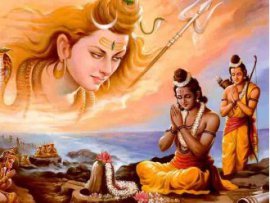
View On WordPress
#atharveda#ayodhya#ayodhya atharveda and Ram#अयोध्या#BB lal#buddhist#dwarka#gori#gupta period#jain#King Dasratha#king harishchandra#mahavir swami#Mir khan#muslim invaders#Prithvi Raj Chauhan#Tulsidas#varanasi#vikramaditya#vishnu puran
0 notes
Text
𝐉𝐚𝐠𝐚𝐭 𝐒𝐡𝐢𝐫𝐨𝐦𝐚𝐧𝐢 𝐓𝐞𝐦𝐩𝐥𝐞







⭑・゚゚・*:༅。.。༅:*゚:*:✼✿✼:*゚:༅。.。༅:*・゚゚・⭑
The Jagat shiromani temple ( Jewel on the head of Lord Vishnu) also known as Meerabai temple located in Amer, Rajasthan. Constructed between 1599 and 1608 is believed to house the idol of Shree Krishna which Meerabai herself worshipped. The idol of Krishna was saved by the rulers of Amer from the Mughal invaders in Mewar and was brought back here.
The garbagriha of the temple houses the idol of Lord Vishnu in white marble, and the idols of Shree Krishna and Meerabai. It is believed that it is the only temple where Krishna and Meerabai are worshipped together.
Built on top of a small hill, one of the most striking features of the temple are it's beautiful 'Torans' (ornamental archways which are usually found in Jain temples). In the canopy adjacent to the temple is a beautifully chiselled statue of Garuda, Lord Vishnu's carrier. The walls and the ceilings of the temple are carved with elephants, horses and scenes from various religious scriptures. One of the entrances of the temple is through the stairways of the Amer fort leading to the temple courtyard.
⭑・゚゚・*:༅。.。༅:*゚:*:✼✿✼:*゚:༅。.。༅:*・゚゚・⭑
117 notes
·
View notes
Photo
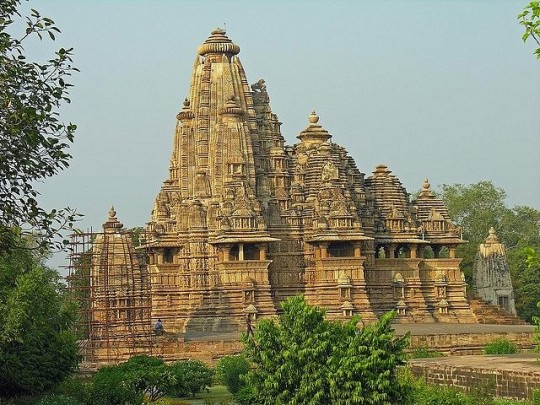
Khajuraho
Khajuraho was an ancient city in the Madhya Pradesh region of northern India. From the 10th to 12th century CE it was the capital of the Chandella kings who ruled Bundelkhand. Despite Khajuraho's once great reputation as an important cultural centre there are no surviving non-religious buildings, but the presence of 35 Hindu and Jain temples make it one of the most significant historical sites in India today and worthy of its name given by the 11th century CE Muslim historian Abu Rihan Alberuni as 'the City of the Gods'. Khajuraho is listed by UNESCO as a World Heritage Site.
Architectural Highlights
Most of the temples at Khajuraho were built using sandstone but four also used granite in their construction. In the latter group is the Chaunsat Yogini (64 tantric goddesses), built c. 875-900 CE, which has 64 shrine rooms arranged around a rectangular courtyard. Next in the site's development came the Lalguan Mahadeva, Brahma, and Matangesvara temples which are all quite plain in design and decoration compared to the later temples.
The majority of temples at Khajuraho were constructed between 950 and 1050 CE and are either Hindu (Saiva or Vaisnava) or Jain. The most famous is the Kandariya Mahadeo built in the early 11th century CE and dedicated to Shiva. The more or less contemporary Laksmana temple was built in 954 CE by King Dhanga (r. 950-999 CE) to celebrate independence from the Gurjara-Pratihara rulers and has a similar layout and exterior to the Kandariya Mahadeo. So too does the Visvanatha temple (c. 1002 CE) which was designed by Sutradhara Chhichchha. Both temples have shrines at each corner of their terrace platforms. The Laksmana was dedicated to Vishnu and its terrace is of particular note as it carries a narrative frieze running around all four sides: Elephants, warriors, hunters, and musicians form a procession watched by a ruler and his female attendants.
Other notable temples at the site include the single-towered Caturbhuja and Vamana, the squat Matulunga, and the rectangular, more austere Parshvanatha Jain temple with its unique shrine added to the rear of the building (c. 950-970 CE). Probably the latest temple at Khajuraho is the Duladeo which was built on a star-plan.
Continue reading...
61 notes
·
View notes
Text

Dharma Eye by Talon Abraxas
Meaning of Symbols Common to Hinduism, Buddhism, and Jainism
1.The Dharma Wheel is the main Buddhist symbol, but it also appears in Hinduism and Jainism. It represents Dharmic views on morality and cosmic law. With eight spokes, it denotes the moral virtues on the Buddhist Eightfold Path.
2.The Swastika is an ancient symbol. Clockwise, it represents the motion of the Sun in Hinduism. Counterclockwise, it is the night and the Hindu goddess Kali. In Buddhism, it symbolizes Buddha's footprints and the cycle of life. In Jainism, the arms denote the four types of rebirth for the soul.
3.The Lotus flower symbolizes divinity, perfection, immortality, and various Hindu deities. In Buddhism, it expresses purity of the body and mind. In Jainism, semi-divine prophets are represented by or seated upon them.
4.The Endless Knot or "Srivatsa" and Pair of Fish appear in Ashtamangala: a set of eight symbols (most are pictograms of sacred objects) that differ between traditions. The knot represents unity, the cycle of rebirth, and wisdom entwined with compassion. The fish symbolize happiness, freedom, and fearlessness.
5.Symbols may be combined into Yantra, which usually have T-shapes on their borders to symbolize inner enlightenment. They may be associated with deities, luck, protection, or used as meditative aids.
Meaning of Other Hindu Symbols
1.The Om appears in all Dharmic traditions (variously translated), although it is technically a written symbol. It is included here because it has become the main symbol of Hinduism. It represents the supreme, divine consciousness.
2.The Ouroboros appears in several religious traditions (the oldest may be Ancient Egypt; see below). In Hindu mythology, it is one of the animals that holds up the world.
3.The Conch shell or "Shankha" represents Vishnu, water, female fertility, longevity, and prosperity.
Meaning of Other Buddhist Symbols
1.The Conch shell also appears in Buddhism. It can be used as a trumpet and thus represents the awakening influence of Buddhist teachings.
2.The Triratna represents the three jewels of Buddhism: the Buddha (enlightened one), Dharma (teachings), and Sangha (clergy).
3.A Bodhi tree is where Buddha achieved awakening, and its symbol thus represents liberation and nirvana.
4.Buddha footprints represent Buddha as a man, and as following a path that all humans can therefore follow.
5.Buddha eyes symbolize his all-seeing nature. Their display may promote moral behavior in a society.
Meaning of Other Jain Symbols
1.The Nandavarta symbolizes teaching, enlightenment, joy, and prosperity.
2.The Ahimsa represents the principle of non-violence (beginning with non-violence against oneself).
Meaning of Sikh Symbols
1.The Khanda is the primary Sikh symbol. It stands for the provision of charity and protection to those who need it.
2.The Harr Nishan is a symbol of the Ravidassia branch of Sikhism. It represents the goal of enlightenment through worship, meditation, and singing.
172 World Religious Symbols and Their Meanings
23 notes
·
View notes
Text
Qutab Minar, New Delhi.
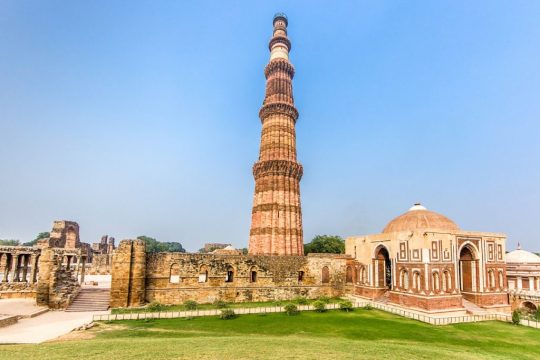
Qutab Minar or “Tower of Victory” 73 m-high tower of victory was built-in 1193 by Qutab-ud-din Aibak. Quwwat-ul-Islam Mosque was the first mosque was built next to it.
Mughal Architecture are famous world wide, but are those really Mughal architecture or stolen pieces from the indigenous people that lived there, that were subjected to slavery and unspeakable tyranny?
Quwwat-ul-Islam Mosque was built by pieces and carvings of 27 destroyed Hindu temples, as it is stated clearly below -
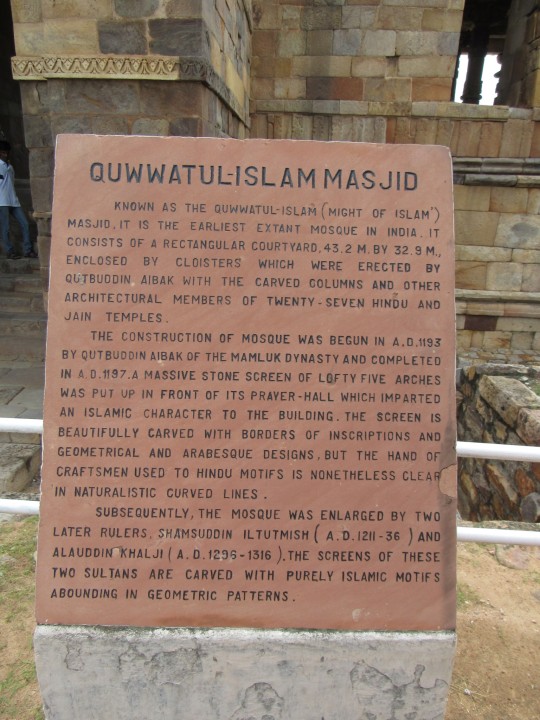
As it is a known fact that Mughals destroyed approximately 40,000 Hindu and Jain temples during their ~300 years of invasion in India.
There are many deities in the complex that are placed in the most disrespectful way. It is not a doubt that this complex, the minar especially was to mock the Hindus that it belonged to. There is carvings of Cows, a holy and sacred animal in Hinduism, that can be seen in many Hindu temples to this day, but not in any mosque whatsoever.

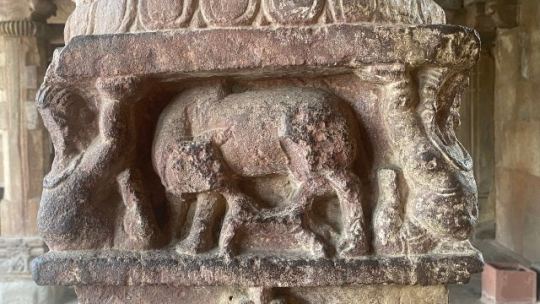
According to Islam, The bell being instrument of Satan, yet there are carvings on pillars of Bells - an instrument that is widely and always used in Hindu Practices.
There are Brahmi and Sanskrit inscriptions found in various spots in the pillar and around the complex.
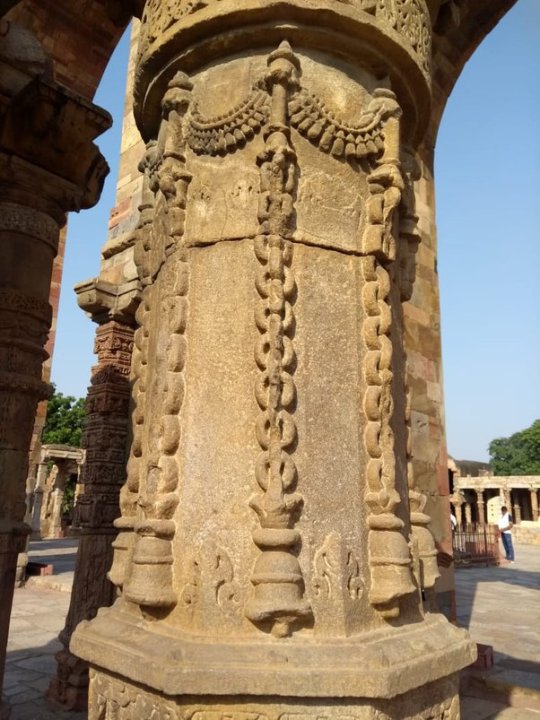
So what Exactly was Qutab Minar.
The township adjoining the Kutub Minar is known as Mehrauli. That is a Sanskrit word Mihira-awali. It signifies the town- ship where the well known astronomer Mihira of Vikramaditya's court lived along with his helpers, mathematicians and technicians. They used the so-called Kutub tower as an observation post for astronomical study. Around the tower were pavilions dedicated to the 27 constellations of the Hindu Zodiac.
The Hindu title of the tower was Vishnu Dhwaj (i.e. Vishnu’s standard) alias Vishnu Stambh alias Dhruv Stambh (i.e., a polar pillar) obviously connoting an astronomical observation tower.
The Sanskrit inscription in Brahmi script on the non-rusting iron pillar close by proclaims that the lofty standard of Vishnu was raised on the hillock named Vishnupad Giri. That description indicates that a statue of the reclining Vishnu initiating the creation was consecrated in the central shrine there which was ravaged by Mohammad Ghori and his henchman Qutubuddin.
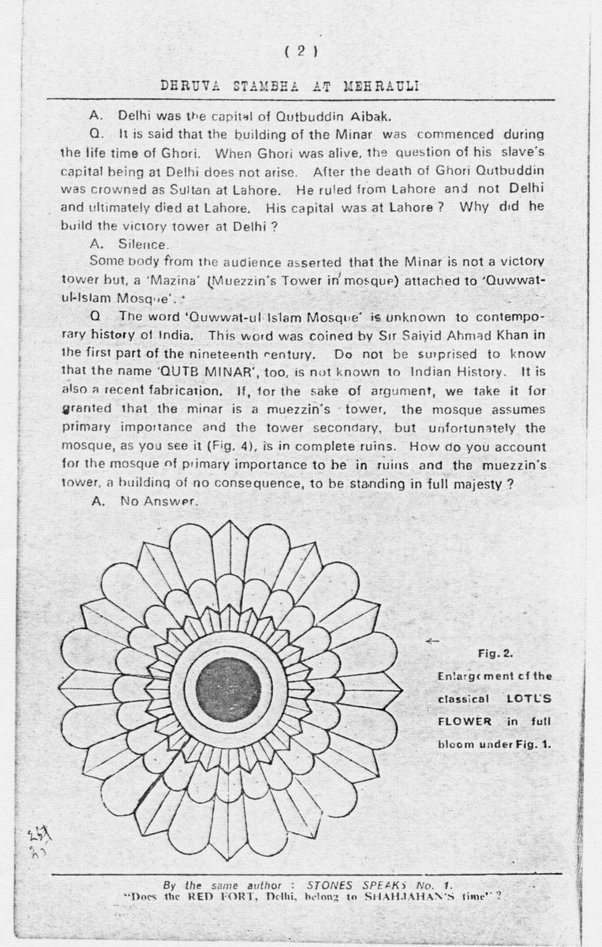
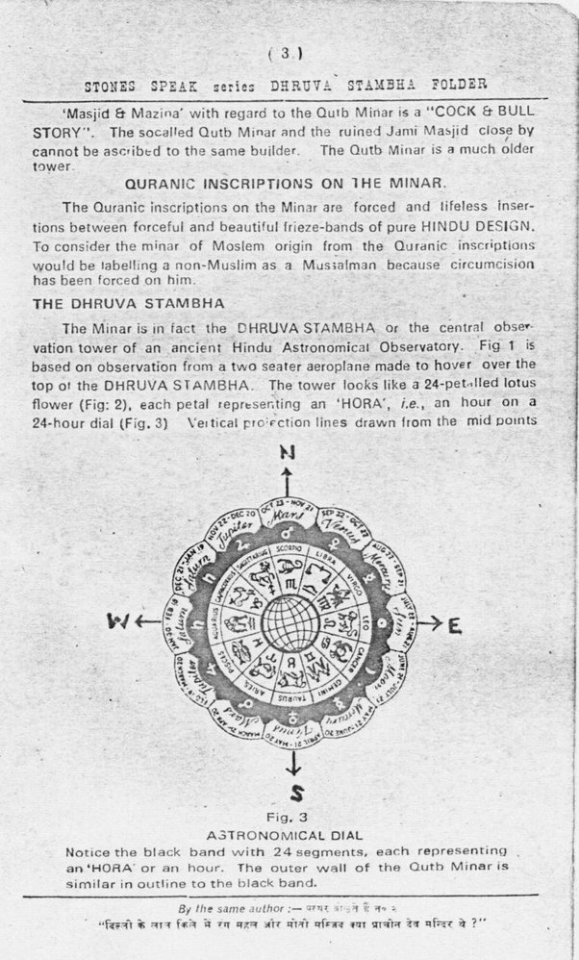
Presence of lotus flowers on the minar’s inscriptions. Lotus flowers do not feature in any Islamic structures of that era. Lotus flower buds have been covered with verses from the Quran. Lotus flowers if we observe are seen in Hindu temples.
Know your history.
धर्मो रक्षति रक्षितः
#qutab minar#mughal architecture#hinduism#hinduphobia#sanatan dharma#indian architecture#india#bharat#pseudo secularism#new delhi#mughal invasion#ancient india#colonization#hindublr#desiblr
43 notes
·
View notes
Text
Nappinnai in Ponniyin Selvan

Krishna-Nappinnai cult was prominent in Tamil-speaking areas of South India in the seventh to tenth centuries. Nappinnai can be considered a mix of Satya of Ashtabharya and Radha. This cult is the prototype of the later Radha-Krishna cult in the North. She features prominently in the poetry of Alwars (Vaishnavite poet saints) as the worldly wife of Krishna as different from the divine consorts of Lord Vishnu.
In Tamil poetry, Nappinnai is the daughter of Yashoda’s brother Kumbakan. She grew up with Krishna and Balarama and Krishna marries her by taming seven bulls in a public tournament. Nappinnai is featured in non-Hindu sources too. For example, in Jivaka Chintamani composed by the Jain saint Tirutakkatevar, a King is told that he shouldn't hesitate to marry a lower class woman because Tirumal himself is married to cowherdess Nappinnai.
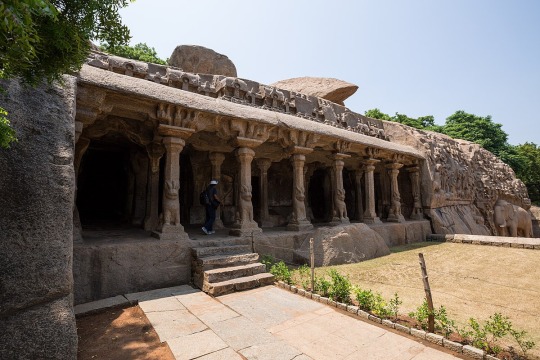
Krishna Mandapam at Mahabalipuram
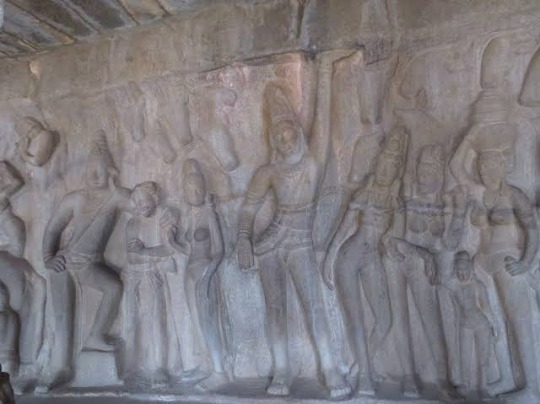
Krishnan lifting Govardhana, Balarama on the right side, consoling an old couple. Nappinnai on the left side gazing at him admiringly, holding the hands of his sister Subhadra.
Aditha Karikalan, Thirukkoilur Malayaman and Parthibendra Pallavan spend their night in this complex near the iconic Shore Temple, at the end of Book 1. The young princes discuss about sculptures and poetry, which Parthibendran finds distasteful. Malayaman leaves them to watch villu pattu in the Pancha ratha complex and it is here that Karikalan narrates the story of his heartbreak. Now it is a closed structure, but originally it was an open air bas relief. The mandapam enclosing it was constructed only in the 16th century, during Vijayanagara period.
An entire chapter (Achchiyar Kuravai) of Silappathikaram is about Nappinnai playing Kuravai dance with Krishan and Balaraman. Manimekalai (Sangham epic, not PS character) too mentions this dance. When Vanthiyathevan gives Aditha Karikalan's letter to Kundavai, Kundavai's retinue is seen dancing to this, singing about various asuras trying to kill Krishnan.
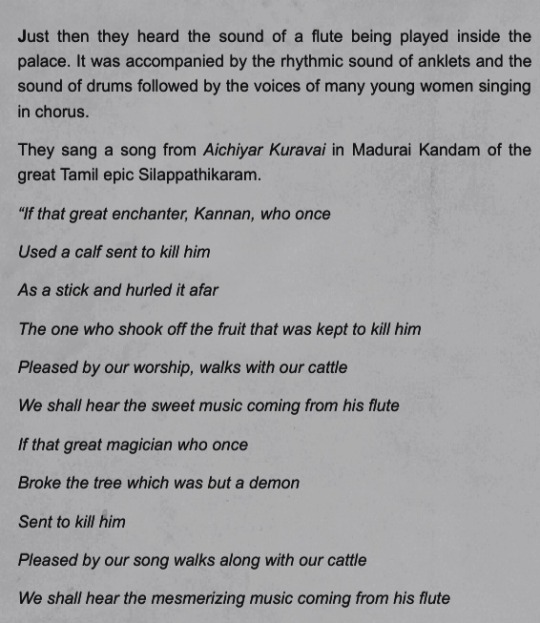
When Karikalan goes to Kadambur, there too we see the preparations for the Kuravai.
While having a heart to heart conversation (as much as someone like Nandini can open her heart), Nandini tells Manimegalai about her hallucinations. According to her, when we love or hate someone intensely, we can see and feel them even in their absence.
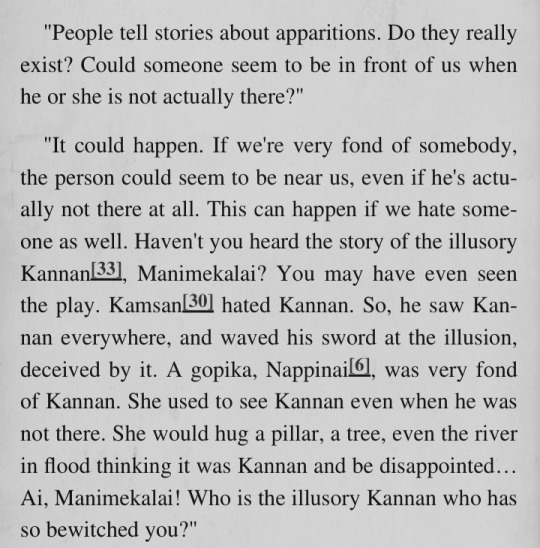
This is something Nandini made up for her consolation, because Nappinnai is never seperated from Krishna. In fact, it said that Vishnu left his divine wives and descended from his seat to be Nappinnai's beloved.
You parted from the eternal Great Flower [Lakshmi] and from the Lady Earth, became a youth, and then united in marriage with the shoulders of the cowherd Pinnai.
In Kuravai Koothu, women sing that Krishna avoids Lakshmi because he is so enamored by Nappinnai.
Is Pinnai of bangled arms so beautiful that He who had won great reputation by measuring the universe, would not look at Lakshmi dwelling in his own breast ?
It is to this Nappinnai that Andal prays to give her an opportunity to get one with Krishna, as her other attempts to wake him up were futile.


Nandini must have heard of the North Indian narratives about viraha unmadini (driven mad by seperation) Radha which were in their infancy then. Nappinnai didn't have the habit of seeing hallucinations - it is Nandini who has mental health issues.
This connection also shows Nandini's guilt about her life's circumstances though they were beyond her control. When Vanthiyathevan tells her that her Krishnan is still waiting for her, she replies that she doesn't deserve it. After marrying Periya Pazhuvettaraiyar, Nandini is never shown praying earnestly - either she is lying about different prayers and austerities or she is using devotion to avoid questions.
Edit: After writing the original post, I thought I will read Thirumangai Alwar's poems because his poetry is specifically mentioned in the chapter which shows Karikalan, Parthibendran and Malayaman going to the port to oversee the loading for goods for Arulmozhi's army. Look what I found:
Pinnai's forehead is a gleaming crescent moon So long ago in battle he subdued seven bulls for her hand And now he owns beautiful Kanchi which is surrounded by beautiful cool ponds of waters Where the sovereign of Pallavas who have the sharp blood stained sword in his hands Who owns a drum with a bitter mouth And the Conch with the roar of the sea Pays his obeisance to his Lord.
(The poem says that the poet's god is the Lord of Kanchi who is worshipped by the Pallava King. The rest are the descriptions of the the god and the king. In PS, crown prince Karikalan is ruling from Kanchi with Parthipendra Pallavan as his vasal)
Very subtle 🤣🤣

Are you even real, Maya Kanna?
@willkatfanfromasia @sowlspace @vibishalakshman @harinishivaa @thelekhikawrites @hollogramhallucination @thegleamingmoon @whippersnappersbookworm @nspwriteups @jukti-torko-golpo @arachneofthoughts @thirst4light
#ponniyin selvan#ponniyin selvan 2#aditha karikalan#nandini#nandhini#nandini x karikalan#kollywood#ps2#ps1
51 notes
·
View notes
Text

Il Diwali, o Festival delle Luci, è una delle più antiche e importanti feste che si celebra nel mese di Ottobre, in tutta l'India. La leggenda narra del ritorno del Re Rama della città di Ayodhya (l’attuale Uttar Pradesh) dopo 14 anni di esilio in una foresta. Negli scritti pervenuti fino ad oggi si legge che il popolo della città, al ritorno del re, accese file di lampade, chiamate dipa, in suo onore; da qui il nome Dipawali o più semplicemente Diwali. Si tratta di una festa dedicata alla luce, intesa sia in senso fisico, sia spirituale, che vede accendersi a giorno tutta la città con lanterne nel cielo o candele galleggianti, a simboleggiare la rinascita dello spirito e la sconfitta delle tenebre. I festeggiamenti possono protrarsi fino a cinque giorni e in questo periodo, gli abitanti delle città prestano particolare attenzione alla cura della casa, indossano abiti nuovi e si scambiano piccoli regali in famiglia. Nel corso dei secoli, il Diwali è diventato un festival nazionale, apprezzato dalla maggior parte degli abitanti, indipendentemente dalla loro fede: che sia essa Indù, Jains, Buddista o Sikhs. Tuttavia, a seconda della zona territoriale, l’interpretazione della festa ed il suo festeggiamento è diverso:
Nell'India settentrionale si celebra la storia del ritorno di Re Rama a Ayodhya dopo aver sconfitto l’antagonista Ravana, illuminando righe di lampade di argilla.
L'India meridionale lo celebra come il giorno in cui il Signore Krishna sconfisse il demone Narakasura.
Nell'India occidentale il festival segna il giorno in cui Lord Vishnu, il Preservatore (uno dei membri principali della trinità indù) mandò il demone Bali a dominare il mondo inferiore.
Nonostante però la differenziazione geografica, il fulcro del festival è lo stesso per tutti coloro che ne prendono parte: la vittoria del bene sul male. www.tesoridoriente.net art by_archanain ***************************** Diwali, or the Festival of Lights, is one of the oldest and most important festivals celebrated in October throughout India. Legend has it that King Rama returned from the city of Ayodhya (now Uttar Pradesh) after 14 years of exile in a forest. In the writings that have survived to this day, we read that the people of the city, upon the king's return, lit rows of lamps, called dipa, in his honor; hence the name Dipawali or more simply Diwali. It is a festival dedicated to light, both in the physical and spiritual sense, which sees the entire city light up with lanterns in the sky or floating candles, to symbolize the rebirth of the spirit and the defeat of darkness. The celebrations can last up to five days and during this period, city dwellers pay particular attention to taking care of the house, wear new clothes and exchange small gifts with each other as a family. Over the centuries, Diwali has become a national festival, enjoyed by most people, regardless of their faith: be it Hindus, Jains, Buddhists or Sikhs.
However, depending on the geographical area, the interpretation of the festival and its celebration is different:
In northern India, the story of King Rama's return to Ayodhya after defeating the antagonist Ravana is celebrated, by lighting rows of clay lamps.
Southern India celebrates it as the day Lord Krishna defeated the demon Narakasura.
In western India, the festival marks the day Lord Vishnu, the Preserver (one of the main members of the Hindu trinity) sent the demon Bali to dominate the lower world.
Despite the geographical differentiation, the focus of the festival is the same for all those who take part in it: the victory of good over evil. www.tesoridoriente.net art by_archanain
2 notes
·
View notes
Text

Vedic Temples 'वैदिक मंदिर' ॐ
“Natya Vishnu” A rare depiction of Natya Vishnu. Could only confirm by identifying ‘Chanka and Chakra’. This is the central part of the Bhuvaneshwari (inner ceiling) surrounded by Asta Dikpalakaras.
Preserved in pieces in the premises of ‘Pancha Basadi’-jain temple Humcha, Sivamoogga, Karnataka, BHARAT (India)
2 notes
·
View notes
Text
Badami – Hidden Gem of Karnataka – Top Things to Do

Karnataka is a state rich in history, culture, and natural beauty, but there are places that remain lesser-known, tucked away from the usual tourist trails. Badami, often referred to as the Hidden Gem of Karnataka, is one such place. This ancient town, nestled amidst rugged sandstone cliffs, is a treasure trove of architectural marvels, historical significance, and spiritual sanctuaries. If you’re seeking an offbeat travel experience, where history whispers through the wind and every corner holds a story, Badami should be on your list.

In this comprehensive guide, we will explore the Top Things to Do in Badami. Ensuring you make the most of your visit to this hidden gem.
Things To See & Do in Badami – Hidden Gem of Karnataka
Badami is not just a destination; it’s an experience. Each site has its own tale, etched in stone and culture, waiting to be discovered. Here’s a list of the must-visit places in Badami that will leave you awe-inspired.
Badami Fort – 6th-century Historic Fort

Perched atop a hill, Badami Fort is a magnificent reminder of the town’s rich past. Built in the 6th century by the Chalukyan rulers, this fort offers a stunning view of the town. The fort’s strategic location atop the cliffs provides a panoramic view that stretches as far as the eye can see.
The trek to the fort is an adventure in itself, with the path winding through ancient gateways, stone-carved steps, and old watchtowers. The fort is also home to Shivalayas, or temples dedicated to Lord Shiva. It showcases intricate carvings and sculptures that are a testament to the artistic prowess of the Chalukyan dynasty.
Exploring the fort, you’ll come across cannons, granaries, and other remnants that speak volumes about the military might of the time. The fort also has a secret passage that was once used by the royals during emergencies. It adds an element of mystery to your visit.
Agastya Lake – Crystal-clear Lake

At the heart of Badami lies Agastya Lake. A serene body of water that is as ancient as the town itself. Surrounded by red sandstone cliffs and the iconic Badami cave temples. The lake is a picture-perfect spot for reflection and relaxation.
According to local legends, the lake is named after the sage Agastya. Who is believed to have created it to quench his thirst during his travels. The lake is considered sacred by the locals, and its waters are believed to have healing properties.
Take a leisurely stroll along the lake’s edge or sit by its banks, and you’ll feel a sense of calm that is hard to find elsewhere. The reflection of the surrounding cliffs and temples on the water creates a mesmerizing view, especially during sunrise and sunset. It’s a peaceful retreat from the hustle and bustle of daily life, where you can soak in the beauty of nature and history.
Cave Temples – Revered Hindu Shrine

The Badami Cave Temples are the crown jewels of the town, drawing visitors from all over the world. Carved into the rugged cliffs, these temples are a marvel of ancient Indian rock-cut architecture. And a testimony to the artistic and spiritual achievements of the Chalukyan dynasty.
There are four main cave temples, each dedicated to a different deity:
Cave 1: Dedicated to Lord Shiva, this cave features a magnificent statue of Nataraja, the dancing form of Shiva. With 18 arms in various poses.
Cave 2: Dedicated to Lord Vishnu, this cave showcases the deity in his incarnations as Varaha (the boar). And Trivikrama (the giant form that spans the universe).
Cave 3: The largest and most ornate of the caves, this one is also dedicated to Vishnu. The intricate carvings depict various scenes from Hindu mythology, showcasing the gods in all their glory.
Cave 4: This cave is dedicated to Jain Tirthankaras. It is a reflection of the religious diversity that existed in the region. The carvings here are more simplistic, yet they carry a deep spiritual significance.
As you explore these caves, you’ll be struck by the sheer scale and detail of the carvings. The cool interiors of the caves offer a respite from the heat. The intricate sculptures and inscriptions will leave you in awe of the ancient craftsmen who created them.
Lower Shivalaya and Upper Shivalaya – Revered Ancient Temples

The Lower Shivalaya and Upper Shivalaya temples are perched on the hills surrounding Badami, offering a unique perspective of the town and its surroundings. These temples, dedicated to Lord Shiva, are relatively lesser-known but are a must-visit for history enthusiasts and spiritual seekers.
The Lower Shivalaya is located at the base of the hill and is a simple yet beautiful structure with detailed carvings that depict scenes from Hindu mythology. As you make your way up the hill, you’ll reach the Upper Shivalaya. It offers a more commanding view of the area.
The Upper Shivalaya is an architectural marvel, with its Dravidian-style tower and intricate stone carvings that have stood the test of time. The temple is surrounded by smaller shrines and sculptures, each telling its own story. The trek to these temples is relatively easy, and the reward at the top is a panoramic view. It stretches across the landscape, making it a perfect spot for photography and quiet contemplation.
Mahakuta Temples – Stunning Ancient Temples

A short drive from Badami will take you to the Mahakuta Temples, a complex of ancient shrines that date back to the 6th century. This site is not as frequented by tourists, making it a peaceful and serene place to explore.
The Mahakuta Temple complex is dedicated to Lord Shiva and is surrounded by lush greenery and natural springs. The main temple is a beautiful example of early Chalukyan architecture, with intricate carvings and a large tank known as the Mahakuta Pushkarini, where devotees take a dip before offering prayers.
One of the unique features of the Mahakuta Temples is the presence of lingas, or phallic symbols of Shiva, in various forms and sizes. The temple complex also has a small shrine dedicated to Lord Vishnu, showcasing the religious harmony that existed during that era.
Walking through the temple grounds, you’ll feel a deep sense of spirituality and tranquility. The sound of the water flowing from the natural springs adds to the peaceful ambiance, making it a perfect place for meditation and reflection.
Malegitti Shivalaya Fort and Temple – 7th-century Historic Fortress

Another hidden gem in Badami is the Malegitti Shivalaya Fort and Temple, a lesser-known but equally captivating site. This 7th-century temple is dedicated to Lord Shiva and is perched on a hilltop, offering stunning views of the surrounding landscape.
The Malegitti Shivalaya is known for its unique architecture, which is a blend of Dravidian and Nagara styles. The temple is relatively small but is adorned with detailed carvings that depict various aspects of Hindu mythology. The fort surrounding the temple is in ruins, but it adds to the charm of the place, giving it a sense of mystery and history.
Reaching the temple requires a short trek, but the effort is well worth it. The views from the top are breathtaking, with the town of Badami and the Agastya Lake spread out below. The temple is often less crowded than the main attractions, making it a perfect spot for those who prefer a quieter, more intimate experience.
Archaeological Museum Badami – Insightful Tourist Destination
For history buffs, a visit to the Archaeological Museum Badami is a must. Located near the Cave Temples, this museum houses a fascinating collection of artifacts, sculptures, and inscriptions that provide insight into the rich history and culture of the region.
The museum is divided into several galleries, each showcasing different aspects of Badami’s heritage. The exhibits include stone sculptures, bronze statues, inscriptions, and terracotta objects that date back to the Chalukyan period.
One of the highlights of the museum is the collection of sculptures from the cave temples, including some unfinished pieces that offer a glimpse into the artistic process of the time. The museum also has a collection of inscriptions in various languages, including Sanskrit, Kannada, and Tamil, which provide valuable information about the history and culture of the region.
A visit to the Archaeological Museum Badami is not just an educational experience but also a journey back in time, offering a deeper understanding of the historical significance of Badami and its surroundings.
Bhuthanatha Temples – Holy Site for Hindus

Situated on the eastern side of Agastya Lake, the Bhuthanatha Temples are a group of ancient shrines dedicated to Lord Shiva in his Bhuthanatha form. These temples are one of the most picturesque and serene spots in Badami, offering a perfect blend of natural beauty and spiritual ambiance.
The main temple is built in Dravidian style and is partially submerged in the waters of Agastya Lake, creating a stunning reflection that is especially beautiful during sunrise and sunset. The temple’s architecture is simple yet elegant, with intricate carvings that depict various deities and mythological scenes.
The Bhuthanatha Temples are a popular spot for both pilgrims and tourists, offering a peaceful retreat where one can connect with nature and spirituality. The sound of the wind rustling through the trees and the sight of the temple
reflected in the tranquil waters of the lake create an atmosphere that is both calming and awe-inspiring.
Visitors often sit by the temple steps, dipping their feet in the cool waters of the lake, or simply taking in the serene surroundings. The Bhuthanatha Temples are also a great place for photography, especially during the golden hours of sunrise and sunset when the light creates a magical effect on the temple and the lake.
For those interested in ancient architecture and spirituality, the Bhuthanatha Temples offer a unique experience that combines the best of both worlds. It’s a place where you can feel the history in every stone and the spirituality in every prayer.
Best Time To Visit Badami – Hidden Gem of Karnataka

Timing your visit to Badami can greatly enhance your experience. The town has a tropical climate, with distinct seasons that each offer a different kind of beauty. Here’s a guide to help you decide when to plan your trip.
Winter Destination
Winter (November to February) is the best time to visit Badami. The weather during these months is cool and pleasant, making it ideal for exploring the outdoor attractions like the cave temples, fort, and lake. The daytime temperatures range between 15°C to 28°C, making it comfortable to walk around and enjoy the sights without the heat.
This season is perfect for travelers who want to explore Badami’s historical and cultural sites in a relaxed and leisurely manner. The cool breeze, clear skies, and the crisp air add a certain charm to the ancient ruins, making your visit even more memorable.
Peak Season
Monsoon (June to October) is another popular time to visit Badami, especially for those who love the lush greenery and the fresh, rain-washed look of the landscape. The monsoon rains breathe new life into the surroundings, with the red sandstone cliffs turning a deeper hue and the Agastya Lake filling up to the brim.
While the rains can sometimes be heavy, they usually occur in short bursts, leaving the air fresh and cool. The waterfalls in and around Badami are in full flow during this time, making it a great season for nature lovers and photographers. However, the wet conditions might make exploring the hilly terrain a bit challenging, so it’s advisable to carry appropriate footwear and rain gear.
Moderate Season
Summer (March to May) in Badami can be quite hot, with temperatures soaring to around 35°C to 40°C. This is not the most comfortable time to visit, especially if you plan to explore the outdoor attractions. However, if you don’t mind the heat, summer can still be a good time to visit, as the town is less crowded, and you can explore the sites at your own pace.
One advantage of visiting during the summer is that the mornings and evenings are relatively cooler, allowing you to explore the sights without too much discomfort. The clear skies also make for great photography, with the golden light of the setting sun casting a beautiful glow on the red sandstone cliffs and temples.
Off-season – Festivals and Events
Badami also has a rich cultural heritage, and visiting during local festivals can offer a unique glimpse into the traditions and customs of the region. The Badami Chalukya Festival, usually held in January or February, is a great time to visit if you want to experience the local culture, with performances of classical music, dance, and drama, as well as traditional crafts and food.
Another significant event is Shivaratri, celebrated with great fervor at the Mahakuta Temples, where thousands of devotees gather to offer prayers and participate in the rituals. The town comes alive with the energy and enthusiasm of the locals, and it’s an experience that you won’t forget.
Book Your Trip to Badami with Ghum India Ghum
https://www.ghumindiaghum.com/blog/wp-content/uploads/2024/08/1024px-HBPA_N_974_Badami_Upper_Shivalaya_zoom_from_Mandapa.jpg
Planning a trip to a destination as unique as Badami requires careful planning and attention to detail. Whether you’re a history buff, a nature lover, or a spiritual seeker, Ghum India Ghum offers curated packages that cater to all your travel needs. Here’s how you can make your trip seamless and enjoyable.
Travel Options to Reach Badami – Hidden Gem of Karnataka
Badami is well-connected by road, rail, and air, making it accessible from various parts of India. Depending on your starting point, you can choose the best mode of transportation to reach this historic town.
Train to Badami
The most convenient way to reach Badami is by train. The Badami Railway Station is well-connected to major cities like Bangalore, Hyderabad, and Hubli. Trains offer a comfortable and scenic journey through the picturesque landscapes of Karnataka. Once you arrive at the station, you can easily hire a taxi or auto-rickshaw to reach your hotel or directly head to the attractions.
The train journey itself is an experience, offering glimpses of the changing scenery as you travel from the bustling cities to the tranquil, historic town of Badami.
Flight to Hubli Airport, Then Train to Badami
For those traveling from distant locations, the nearest airport to Badami is Hubli Airport, which is about 105 kilometers away. Hubli is well-connected to major Indian cities like Mumbai, Bangalore, and Chennai. From Hubli, you can take a train or hire a cab to Badami.
This option is ideal for those who prefer a quicker journey, as flying to Hubli and then taking a train or cab to Badami can save you time while still allowing you to enjoy the scenic beauty of Karnataka.
Discover by Interest – More Packages from Ghum India Ghum
If you’re looking to extend your trip or explore other parts of India, Ghum India Ghum offers a variety of packages tailored to different interests. Whether you’re in the mood for a serene hill station, a beach getaway, or a romantic retreat, there’s something for everyone.
Serene Hill Stations
Experience the tranquility and natural beauty of India’s hill stations with our specially curated package. Explore destinations like Manali, Kasol, and Kheerganga on this scenic trek.
Explore More: Serene Hill Stations Package
Best Beach Destinations
For those who prefer sun, sand, and sea. Our beach destinations package takes you to some of India’s most beautiful beaches. Like Goa, Kerala, and Andaman.
Explore More: Best Beach Destinations Package
Perfect Weekend Spots
Short on time? Our weekend getaway packages are perfect for a quick but fulfilling escape. Visit places like Haridwar and Rishikesh for a refreshing break.
Explore More: Perfect Weekend Spots Package
Idyllic Romantic Destinations
If you’re planning a romantic trip. Our packages include some of the most idyllic destinations like Andaman, Havelock Island, and Neil Island.
Explore More: Idyllic Romantic Destinations Package
Honeymoon Destinations
Start your married life with a memorable honeymoon in the most beautiful destinations in Tamil Nadu and Kerala. Our honeymoon packages are designed to give you the best experience.
Explore More: Honeymoon Destinations Package
FAQs – Frequently Asked Questions about Badami – Hidden Gem of Karnataka
Q1: What is the best way to reach Badami? A: The most convenient way to reach Badami is by train. Badami Railway Station is well-connected to major cities. You can also fly to Hubli Airport and take a train or cab to Badami.
Q2: How many days are enough to explore Badami? A: A 2 to 3-day trip is ideal to explore the main attractions in Badami. Which includes the cave temples, fort, and surrounding areas.
Q3: Is Badami safe for solo travelers? A: Yes, Badami is generally safe for solo travelers. The locals are friendly, and the town is well-visited by tourists. However, it’s always advisable to take standard precautions, especially when traveling alone.
Q4: What should I pack for a trip to Badami? A: Comfortable walking shoes, light clothing for summer, warm clothes for winter, and rain gear if visiting during the monsoon. Don’t forget your camera to capture the stunning views!
Q5: Are there good accommodation options in Badami? A: Yes, Badami offers a range of accommodation options, from budget hotels to mid-range and luxury resorts. It’s advisable to book in advance, especially during peak tourist season.
Q6: Can I visit Badami as a day trip from Bangalore? A: While it’s possible to visit Badami as a day trip from Bangalore, it’s recommended to stay overnight to fully explore the town and its surroundings.
Q7: What other places can I visit near Badami? A: Nearby attractions include Aihole, Pattadakal, and the Mahakuta Temples. These sites are rich in history and are well worth a visit.
Conclusion | Badami – Hidden Gem of Karnataka
Badami is truly a hidden gem in Karnataka, offering a unique blend of history, culture, and natural beauty. Whether you’re drawn to the ancient cave temples, the serene Agastya Lake, or the fascinating forts. Badami provides an experience that’s both enriching and unforgettable. With its rich history, stunning architecture, and vibrant culture. This small town in Karnataka is a destination that deserves to be on every traveler’s bucket list.
From exploring the 6th-century Badami Fort to marveling at the intricate carvings in the Cave Temples, there’s no shortage of things to do in Badami. The town offers a perfect mix of adventure, spirituality, and tranquility. Making it an ideal getaway for all kinds of travelers.
The best time to visit Badami depends on your preferences, whether it’s the cool winter months, the lush monsoon season, or the quiet summer. And with Ghum India Ghum’s curated travel packages, planning your trip to this hidden gem becomes hassle-free and enjoyable.
So why wait? Pack your bags and get ready to discover Badami – a hidden gem of Karnataka. It promises to leave you with memories that will last a lifetime.
Whether you’re looking for a peaceful retreat, a historical adventure, or a spiritual journey, Badami has it all. Book your trip now with Ghum India Ghum and explore the best of what this incredible destination has to offer.
#culture#Badami – Hidden Gem of Karnataka – Top Things to Do#Badami#Hidden Gem of Karnataka#Top Things to Do#best place to visit#Karnataka#south india tour package#travel agent in delhi#travel agents in delhi#travel agents in india#tour operators in delhi#tour operators in india#tour operator in delhi#golden triangle package#travel agency in india#travel agency in delhi#rajasthan tour package#kerala tour package#himachal tour package#international tour package#jaipur tour package#varanasi tour package
2 notes
·
View notes
Text
5 Interesting facts about Diwali
Diwali, the Indian festival of lights, is one of the most widely celebrated religious occasions across the world. Here are some of the most surprising facts about Diwali that you probably didn’t know.
1. The day Lakshmi visits her devotees

Goddess Lakshmi visits her devotees and bestows gifts and blessings upon each of them. To welcome the Goddess, devotees clean their houses, decorate them with finery and lights, and prepare sweet treats and delicacies as offerings. Devotees believe the happier Lakshmi is with the visit, the more she blesses the family with health and wealth.
2. Different Diwali stories

Many see Diwali honouring the return of the lord Rama, his wife Sita and his brother Lakshmana from exile, as told in the ancient Hindu epic called the Ramayana. To some, Diwali marks the return of Pandavas after 12 years of Vanvas and one year of agyatavas in the other ancient Hindu epic called the Mahabharata. Many other Hindus believe Diwali is linked to the celebration of Lakshmi, the goddess of wealth and prosperity, and wife of deity Vishnu. The five day festival of Diwali begins on the day Lakshmi was born from the churning of cosmic ocean of milk during the tug of war between the forces of good and forces of evil; the night of Diwali is the day Lakshmi chose Vishnu as her husband and then married him. Some Hindus offer pujas to additional or alternate deities such as Kali, Ganesha, Saraswati, and Kubera. Other Hindus believe that Diwali is the day Vishnu came back to Lakshmi and their abode in the Vaikuntha; so those who worship Lakshmi receive the benefit of her good mood, and therefore are blessed with mental, physical and material well-being during the year ahead. But mostly the festival is considered the return of the Lord Rama and Sita after completing fourteen years in exile.
3. On the day of Diwali, Lord Mahavira attained his Moksha
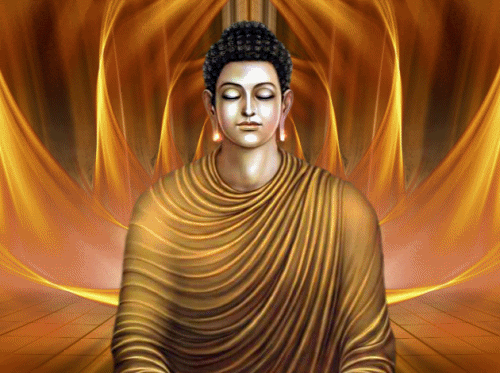
In Jainism, Diwali commemorates the anniversary of Lord Mahavir‘s attainment of moksha, or freedom from the cycle of reincarnation, in 527 B.C.E. Lord Mahavir was the 24th and last Thirtankar of Jainism and revitalized the religion as it is today. First referred to in Jain scriptures as dipalikaya, or light leaving the body, it is said that the earth and the heavens were illuminated with lamps to mark the occasion of Lord Mahavir’s enlightenment.
4. Sikhs commonly called Diwali Bandi Chhor Divas
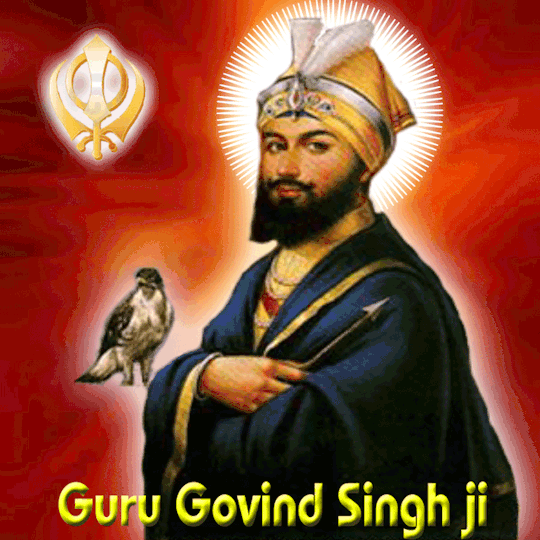
Diwali, for Sikhs, marks the Bandi Chhor Divas, when Guru Har Gobind Ji freed himself and Hindu Kings, from Fort Gwalior, from the prison of Islamic ruler Jahangir, and arrived at the Golden Temple in Amritsar. Ever since then, Sikhs celebrate Bandi Choor Divas, with the annual lighting up of Golden Temple, fireworks and other festivities.
5. It is a national holiday in India, Trinidad & Tobago, Myanmar, Nepal, Mauritius, Guyana, Singapore, Suriname, Malaysia, Sri Lanka and Fiji. And is an optional holiday in Pakistan.

Diwali is celebrated around the world, particularly in countries with significant populations of Hindu, Jain and Sikh origin. These include Sri Lanka, Pakistan, Myanmar, Thailand, Malaysia, Singapore, Indonesia, Australia, New Zealand, Fiji, Mauritius, Kenya, Tanzania, South Africa, Guyana, Suriname, Trinidad and Tobago, the Netherlands, Canada, the United Kingdom,United Arab Emirates, and the United States. With more understanding of Indian culture and global migration of people of Indian origin, the number of countries where Diwali/Deepavali is celebrated has been gradually increasing. While in some countries it is celebrated mainly by Indian expatriates, in others it is becoming part of the general local culture. In most of these countries Diwali is celebrated on the same lines as described in this article with some minor variations. Some important variations are worth mentioning.
9 notes
·
View notes
Text
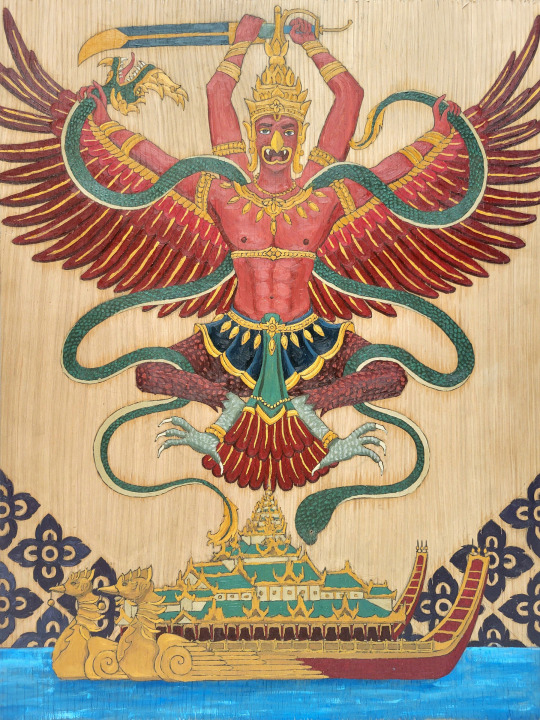
Garuda Karaweik / गरुड ကရဝိက်
The image of an eagle devouring a snake is a national symbol of Mexico, based on an ancient prophecy fulfilled by the founding of Tenochtitlan in 1325. In Hindu, Buddhist, and Jain mythology, the garuda गरुड is a shapeshifting eagle deity, divine mount of Vishnu, and avid consumer of the nāga नाग (serpent deity). The garuda also appears as a national emblem in India, Thailand, and Indonesia.
3 notes
·
View notes
Text
Seeking Spiritual Essence in Bihar: Where to Explore Pilgrimage and Sacred Sites?

Introduction:
Bihar, a cradle of spirituality, unfolds its divine essence through numerous pilgrimage sites. Embarking on a sacred journey is made seamless with the accessibility of the best outstation taxi services. Join us as we explore the spiritual gems that define Bihar's cultural and religious tapestry.
Exploring Bihar's Sacred Tapestry: A Spiritual Odyssey
Now that your outstation taxi is ready to navigate the sacred landscapes of Bihar, let's deepen our exploration into the heart of spirituality.
1. Mahabodhi Temple: A Sanctum of Enlightenment:
Our spiritual journey begins at the Mahabodhi Temple in Bodh Gaya, where Gautama Buddha attained enlightenment. Book an outstation taxi service near you to embark on this sacred pilgrimage. The serene ambiance and ancient architecture make it a must-visit for seekers of spiritual wisdom. Map My Destination can guide you through the pilgrimage route, ensuring a seamless and enriching experience.
2. Gurdwara Patna Sahib: Sikh Sanctity:
Patna Sahib Gurudwara, the birthplace of Guru Gobind Singh, radiates spiritual significance for the Sikh community. Utilize the best outstation cab service to immerse yourself in the serenity of this sacred site. Map My Destination can assist in planning your route, ensuring a harmonious journey through Sikh sanctity.
3. Vishnupad Temple in Gaya: Divine Footprints:
Vishnupad Temple in Gaya is a revered site where Lord Vishnu is believed to have left his footprints. Hire a cab for outstation travel to experience the divine aura and participate in the rituals performed by pilgrims. Map My Destination can guide you through the pilgrimage trail, ensuring you don't miss the sacred steps.
4. Kesaria Stupa: Buddhist Legacy:
Kesaria Stupa, one of the largest Buddhist stupas in the world, stands as a testament to Bihar's Buddhist legacy. Opt for the best outstation cab service to visit this ancient site that echoes the teachings of Lord Buddha. Map My Destination can help you navigate through the historical landscapes, unveiling the Buddhist heritage of Bihar.
5. Mundeshwari Devi Temple: Ancient Sanctity:
Mundeshwari Devi Temple, believed to be one of the oldest temples in Bihar, holds immense historical and religious significance. Hire a cab for outstation travel to reach this ancient site dedicated to Goddess Shakti. Map My Destination can guide you through the scenic routes leading to the temple, allowing you to absorb the spiritual energy surrounding this sacred abode.
6. Pawapuri: The Jain Pilgrimage:
Pawapuri, known as the place where Lord Mahavira, the founder of Jainism, attained Nirvana, is a significant Jain pilgrimage site. Opt for the best outstation cab service to visit this tranquil town surrounded by lotus-filled ponds. Map My Destination ensures a serene and harmonious journey to this sacred Jain destination.
Why Opt for Outstation Taxi Services?
To explore Bihar's sacred sites hassle-free, outstation cabs near you provide easy access to these spiritual destinations. Choose the best outstation cab service, such as an Innova for outstation travel, for a comfortable journey through Bihar's diverse landscapes. Safety remains a priority with reputable outstation taxi services, allowing you to delve into spiritual wonders without transportation concerns.
Booking Your Spiritual Expedition:
Utilize keywords like "outstation cab booking near me" to find reliable services. Enhance your travel experience by exploring options like "hire innova for outstation" for a spacious and luxurious journey. Plan your route with Map My Destination for an efficient and enjoyable spiritual expedition.
Capturing Spiritual Moments: Documenting the Journey:
Immerse yourself in the spirituality of Bihar's sacred landmarks, capturing the serenity through your lens. Share your experiences on social media using hashtags like #SpiritualBihar or #SacredJourney. Connect with fellow seekers, creating a digital sanctuary of shared spiritual explorations. Map My Destination can be your guide in sharing the sacredness with others.
Innova for Outstation: A Serene Voyage Through Devotion:
Choosing an Innova for outstation travel ensures not just comfort but also a serene touch to your spiritual exploration. The spacious interiors and smooth ride complement the tranquil landscapes, making your journey as peaceful as the sacred sites themselves.
One-Way Outstation Taxi: A Contemplative Sojourn Through Devotion:
With a one-way outstation taxi service, take your time to absorb the spiritual energy of Bihar. Each sacred site unfolds its stories without the constraints of a fixed return schedule, allowing you to relish the significance of every step on your contemplative journey.
Sharing Spiritual Chronicles: Documenting the Odyssey:
Capture the essence of Bihar's sacred pilgrimage sites through your camera lens. Share your experiences on social media using hashtags like #SpiritualOdysseyBihar or #SacredRetreat. Connect with fellow seekers, creating a digital anthology of shared spiritual expeditions. Map My Destination can help you share the sacredness with a wider audience.
Conclusion: A Spiritual Odyssey Through Bihar:
As you traverse Bihar's sacred landscapes, let the spiritual energy guide you through an odyssey of the soul. Your outstation taxi is not just a mode of transport; it's your chariot to witness the unfolding narratives of Bihar's spiritual legacy.
Book your outstation cab and step into the divine essence, where each sacred site beckons with stories of enlightenment, sanctity, and cultural resonance. The spiritual odyssey awaits, promising a journey through the heart of Bihar's enduring legacy!
#tourism#travel#taxi service#holiday#holidaypackages#vacation#vacationpackage#outstation trip#trip#travel destinations#traveling#explore
2 notes
·
View notes